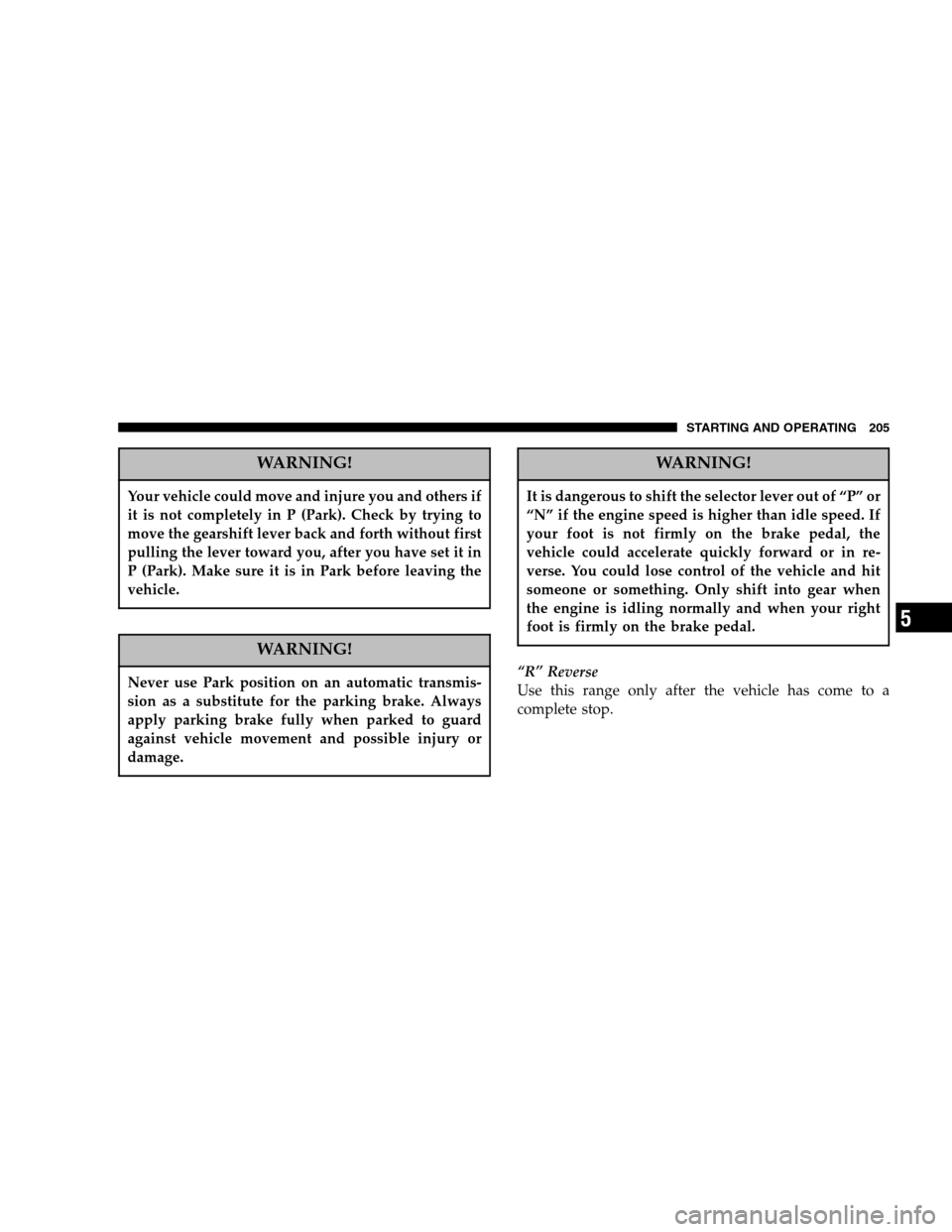Page 199 of 408

�Fuel Requirements ......................250
▫ Reformulated Gasoline .................251
▫ Gasoline/Oxygenate Blends ..............251
▫ MMT In Gasoline .....................252
▫ Materials Added To Fuel ................252
▫ Adding Fuel .........................253
▫ Fuel System Cautions ..................255
▫ Carbon Monoxide Warnings ..............256
� Catalytic Converter .....................256
� Vehicle Loading ........................258
▫ Certification Label .....................258
▫ Curb Weight .........................259
▫ Loading ............................259 �
Trailer Towing .........................261
▫ Common Towing Definitions .............261
▫ Trailer Hitch Classification ...............264
▫ Trailer Towing Weights
(Maximum Trailer Weight Ratings) .........265
▫ Trailer And Tongue Weight ..............265
▫ Towing Requirements ..................266
▫ Towing Tips .........................270
▫ Trailer Towing Mirrors — If Equipped ......272
� Snowplow ............................272
▫ Dodge Dakota Models ..................272
� Recreational Towing (Behind Motorhome, Etc.) . . 273
▫ Recreational Towing 2WD Models .........273
STARTING AND OPERATING 199
5
Page 201 of 408

STARTING PROCEDURES
The starter should not be operated for more than 15
second intervals. Waiting a few seconds between such
intervals will protect the starter from overheating.
Manual Transmission
Apply the parking brake, place the gearshift control lever
in NEUTRAL and depress clutch pedal to the floor before
starting the vehicle. This vehicle is equipped with a
clutch interlocking ignition system. It will not start unless
the clutch is depressed.
Automatic Transmission
Start the engine with the shift lever in NEUTRAL or
PARK position. Apply the brake before shifting to any
driving range.
WARNING!
Do not attempt to push or tow your vehicle to get it
started. Vehicles equipped with an automatic trans-
mission cannot be started this way. Unburned fuel
could enter the catalytic converter and once the
engine has started, ignite and damage the converter
and vehicle. If the vehicle has a discharged battery,
booster cables may be used to obtain a start from a
booster battery or the battery in another vehicle. This
type of start can be dangerous if done improperly.
See section 6 of this manual for the proper jump
starting procedures and follow them carefully.
STARTING AND OPERATING 201
5
Page 203 of 408

WARNING!
Never pour fuel or other flammable liquid into the
throttle body air inlet opening in an attempt to start
the vehicle. This could result in a flash fire, causing
serious personal injury.
After Starting
The idle speed is automatically controlled on fuel injected
engines and will decrease as the engine warms up.
CAUTION!
Long periods of engine idling can cause excessive
exhaust temperatures which can damage your ve-
hicle. Do not leave your vehicle unattended with the
engine running.
WARNING!
Do not leave children or animals inside parked
vehicles in hot weather. Interior heat build up may
cause serious injury or death.
Engine Block Heater — If Equipped
The engine block heater warms engine coolant and
permits quicker starts in cold weather. Connect the cord
to a standard 110-115 volt AC electrical outlet with a
grounded, three wire extension cord.
The engine block heater cord is located at the right front
of the engine compartment for all engine applications.
STARTING AND OPERATING 203
5
Page 204 of 408

WARNING!
Remember to disconnect the cord before driving.
Damage to the 110-115 volt electrical cord could
cause electrocution.
AUTOMATIC TRANSMISSION
Automatic Transmission
The electronic PRNDL on the instrument cluster indicates
the transmission gear selected. The selector lever is
mounted on the right side of the steering column. To
drive, move the selector lever from Park or Neutral to the
desired drive position. Pull selector lever toward you
when shifting into Reverse, Second, First or Park, or
when shifting out of Park.
Brake/Transmission Interlock System
This system prevents you from moving the gear shift out
of Park and into any gear unless the brake pedal is
pressed. This system is active only while the ignition
switch is in the ON position. Always depress the brake
pedal first, before moving the gear selector out of PARK.
Gear Ranges
DO NOT race the engine when shifting from Park or
Neutral position into another gear range.
“P” Park
Supplements parking brake by locking the transmission.
Engine can be started in this range. Never use Park while
vehicle is in motion. Apply parking brake when leaving
vehicle in this range. Always apply parking brake first,
then place selector in Park position.
204 STARTING AND OPERATING
Page 205 of 408

WARNING!
Your vehicle could move and injure you and others if
it is not completely in P (Park). Check by trying to
move the gearshift lever back and forth without first
pulling the lever toward you, after you have set it in
P (Park). Make sure it is in Park before leaving the
vehicle.
WARNING!
Never use Park position on an automatic transmis-
sion as a substitute for the parking brake. Always
apply parking brake fully when parked to guard
against vehicle movement and possible injury or
damage.
WARNING!
It is dangerous to shift the selector lever out of “P” or
“N” if the engine speed is higher than idle speed. If
your foot is not firmly on the brake pedal, the
vehicle could accelerate quickly forward or in re-
verse. You could lose control of the vehicle and hit
someone or something. Only shift into gear when
the engine is idling normally and when your right
foot is firmly on the brake pedal.
“R” Reverse
Use this range only after the vehicle has come to a
complete stop.
STARTING AND OPERATING 205
5
Page 212 of 408

NOTE:The transfer case Neutral (N) position is to be
used for recreational towing only. See Recreational Tow-
ing section for specific procedures on shifting into and
out of Neutral (N).
Transfer Case Position Indicator Lights
Transfer case position indicator lights are located on the
instrument cluster. If there is no indicator light on or
flashing, the transfer case position is two-wheel drive
(2WD). If the indicator light is on, the desired position
(4HI or 4LO) has been obtained.
If One or More Shift Requirements are not Met:
1. An indicator light will flash.
2. The transfer case will notshift.
NOTE: Before retrying a selection, make certain that all
the necessary requirements for selecting a new transfer
case position have been met. To retry the selection, turn
the control knob back to the current position, wait five (5) seconds, and retry selection. To find the shift require-
ments, refer to the
�Shifting Procedure �for your transfer
case, located in this section of the owner’s manual.
The “SVC 4WD” warning light monitors the electric shift
4WD system. If this light remains on after engine start up
or illuminates during driving, it means that the 4WD
system is not functioning properly and that service is
required.
WARNING!
Always engage the parking brake when powering
down the vehicle if the �SVC 4WD�light is illumi-
nated. Not engaging the parking brake may allow
the vehicle to roll, which may cause personal injury.
212 STARTING AND OPERATING
Page 213 of 408

NOTE:Do not attempt to make a shift while only the
front or rear wheels are spinning. The NV233/243 trans-
fer case is not equipped with a synchronizer and there-
fore the front and rear driveshaft speeds must be equal
for the shift to take place. Shifting while only the front or
rear wheels are spinning can cause damage to the trans-
fer case.
When operating your vehicle in 4LO, the engine speed is
approximately three times that of the 2WD or 4HI
positions at a given road speed. Take care not to over-
speed the engine and do not exceed 25 mph (40 km/h).
Proper operation of 4 wheel drive vehicles depends on
tires of equal size, type and circumference on each wheel.
Any difference in tire size can cause damage to the
transfer case.
Because 4 wheel drive provides improved traction, there
is a tendency to exceed safe turning and stopping speeds.
Do not go faster than road conditions permit.WARNING!
You or others could be injured if you leave the
vehicle unattended with the transfer case in the
Neutral (N) position without first fully engaging the
parking brake. The transfer case Neutral (N) position
disengages both the front and rear driveshafts from
the powertrain and will allow the vehicle to move
regardless of the transmission position. The parking
brake should always be applied when the driver is
not in the vehicle.
For additional information on the appropriate use of each
transfer case mode position see the information below:
2WD
Rear Wheel Drive High Range - Normal street and
highway driving. Dry hard surfaced roads.
STARTING AND OPERATING 213
5
Page 218 of 408

flashing the transfer case position is all-wheel drive
(AWD). If an indicator light is on, the desired position
(4HI or 4LO) has been met.
If One or More Shift Requirements are not Met
1. An indicator light will flash until conditions are met.
2. The transfer case will notshift.
NOTE: Before retrying a selection, make certain that all
the necessary requirements for selecting a new transfer
case position have been met. To retry the selection, turn
the control knob back to the current position, wait five (5)
seconds, and retry selection. To find the shift require-
ments, refer to the �Shifting Procedure �for your transfer
case, located in this section of the owner’s manual.
The SERVICE 4WD warning light monitors the electric
shift 4WD system. If this light remains on after engine start up or illuminates during driving, it means that the
4WD system is not functioning properly and that service
is required.
WARNING!
Always engage the parking brake when powering
down the vehicle if the
�SVC 4WD�light is illumi-
nated. Not engaging the parking brake may allow
the vehicle to roll, which may cause personal injury.
NOTE: Do not attempt to make a shift while only the
front or rear wheels are spinning. The NV244 transfer
case is not equipped with a synchronizer and therefore
the front and rear driveshaft speeds must be equal for the
shift to take place. Shifting while only the front or rear
wheels are spinning can cause damage to the transfer
case.
218 STARTING AND OPERATING